Few actors in Hollywood history possessed the ability to convey genuine emotion with the authenticity and depth that James Stewart brought to his performances. With his distinctive drawl, lanky physicality, and unmatched talent for portraying moral decency under pressure, Stewart created characters that continue to resonate with audiences decades after his films first premiered. His performances weren’t merely acted—they were lived, with a vulnerable sincerity that made audiences feel they were watching not a star, but a fellow human being struggling with universal challenges. Here are twelve performances where Stewart’s emotional honesty and remarkable talent created moments of cinema that continue to move viewers to this day.
1. George Bailey in “It’s a Wonderful Life” (1946)
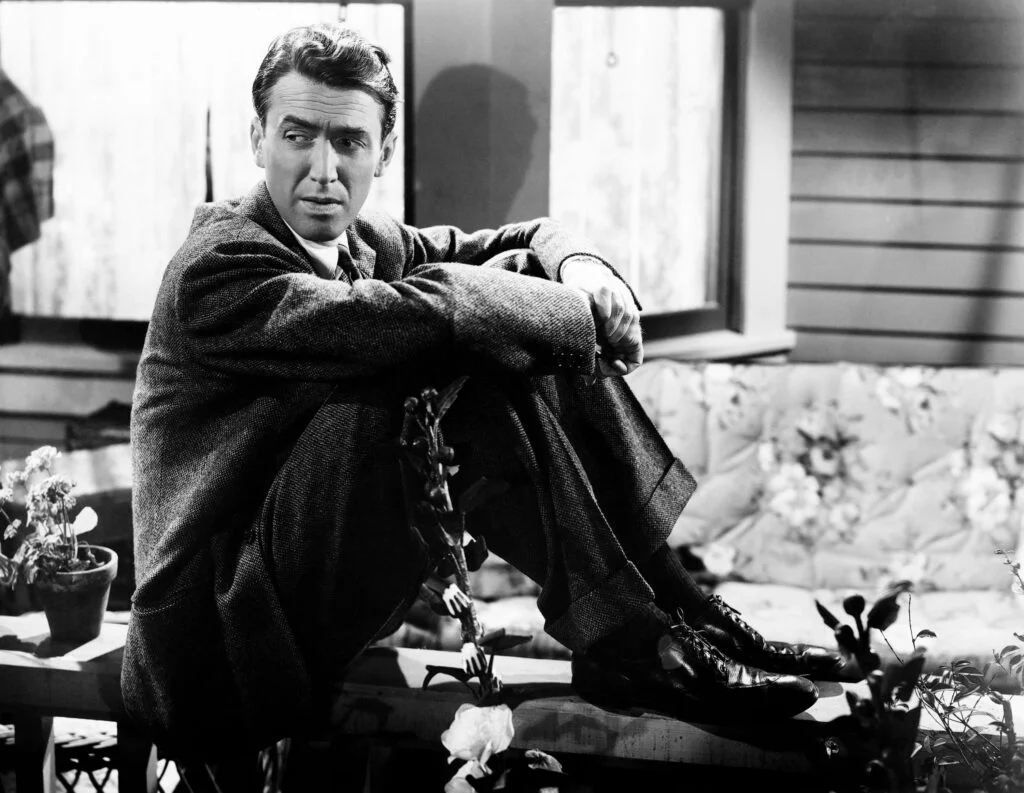
James Stewart’s portrayal of George Bailey—a man who sacrifices his own dreams to help others, only to face a crisis that drives him to contemplate suicide on Christmas Eve—remains perhaps the most beloved performance of his storied career. Stewart, recently returned from combat duty in World War II and struggling with his own post-traumatic stress, channeled his personal emotional turmoil into the character, creating a portrayal of desperation and redemption that feels almost uncomfortably intimate. The scene where George prays in Martini’s Bar, his face contorted with anguish and voice breaking as he begs for help, reveals a raw vulnerability rarely seen in 1940s cinema and demonstrates Stewart’s willingness to strip away all actorly pretense to reach emotional truth. CNN further explores how World War II shaped this timeless holiday film.
The film’s famous ending, with George reunited with his family and community as they rally to save him financially, showcases Stewart’s unparalleled ability to portray overwhelming joy emerging from profound despair. His tearful realization that his seemingly ordinary life has touched countless others represents the perfect culmination of Stewart’s performance—one that progressively reveals the inner conflicts, suppressed dreams, and ultimate redemption of a fundamentally decent man pushed to his breaking point. Though initially a box office disappointment, the film’s eventual recognition as a holiday classic stems largely from Stewart’s emotionally transparent performance, which transforms what could have been sentimental material into something genuinely transcendent and spiritually meaningful.
2. Jefferson Smith in “Mr. Smith Goes to Washington” (1939)
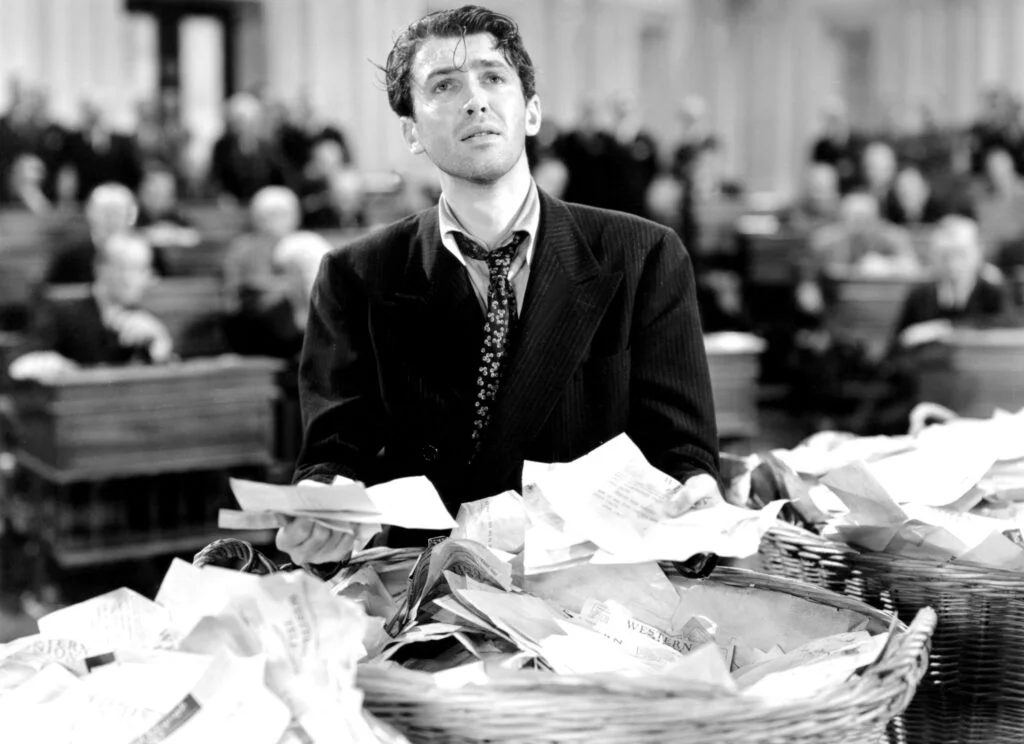
Stewart’s portrayal of Jefferson Smith, an idealistic young senator who stands against political corruption even as it threatens to destroy him, captured the American imagination at a time when faith in democratic institutions was being tested by global totalitarianism. His famous filibuster sequence, where Smith speaks until physically exhausted to prevent the passage of a corrupt bill, showcases Stewart’s remarkable ability to physically embody moral conviction—his voice grows hoarser, his movements more desperate, and his eyes more fevered as the character pushes himself beyond normal human endurance. Throughout this grueling sequence, Stewart allows us to see not just Smith’s determination but also his moments of doubt and fear, creating a hero who triumphs not because he’s fearless but because he continues despite his fear. Civics For Life muses over the environment of idealism and hope that the film establishes in a unique way.
What makes Stewart’s performance particularly affecting is how he balances Smith’s folksy naïveté with a growing understanding of political reality without losing his fundamental moral center. The scene where Smith discovers his mentor’s betrayal—portrayed with devastating emotional transparency as Stewart’s expression shifts from confusion to disbelief to heartbroken understanding—remains one of cinema’s most powerful depictions of lost innocence. By the film’s conclusion, Stewart has taken the character from wide-eyed idealist to battle-scarred champion of democracy, a transformation made believable through the actor’s willingness to inhabit every painful step of Smith’s journey, creating a performance that continues to inspire viewers’ faith in the possibility of political integrity against seemingly impossible odds.
3. Elwood P. Dowd in “Harvey” (1950)
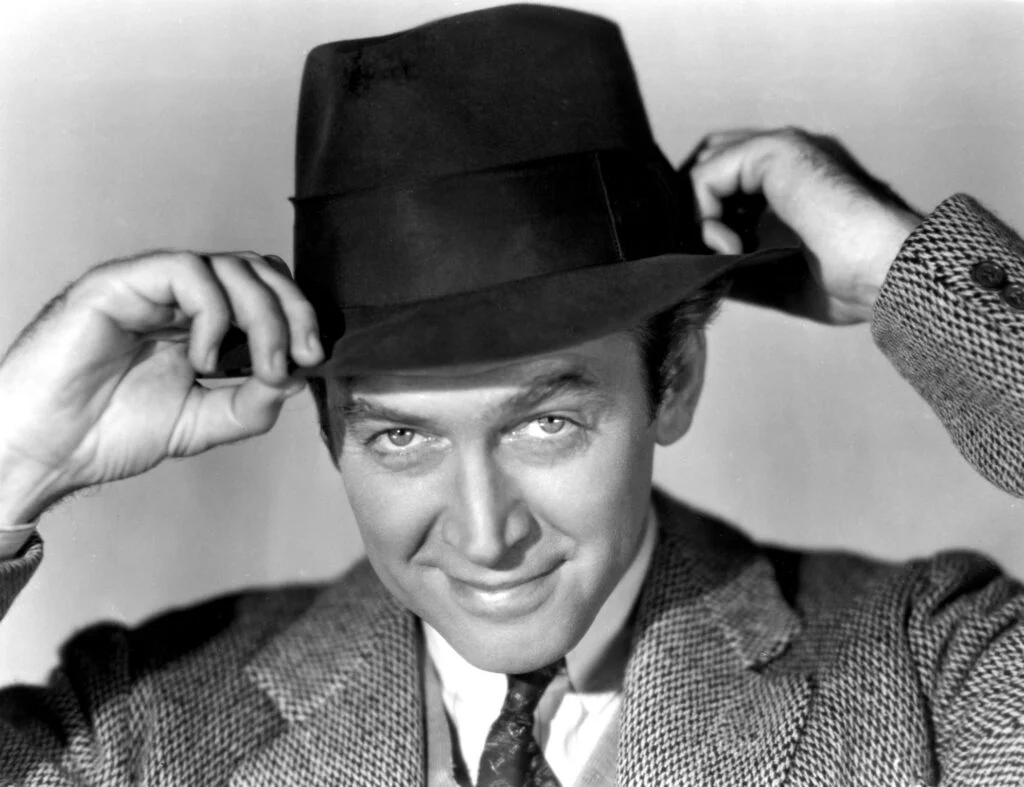
In what may be his gentlest, most whimsical performance, Stewart portrayed Elwood P. Dowd, a kind-hearted man whose best friend happens to be a six-foot-three-and-a-half-inch tall invisible rabbit named Harvey. What could have been merely a comedic caricature becomes, in Stewart’s hands, a deeply moving portrait of a man whose benevolent worldview stands in stark contrast to the “sanity” of those around him. Stewart’s genius in this role lies in his absolute commitment to Dowd’s reality—he never winks at the audience or suggests any doubt about Harvey’s existence, creating instead a character whose serenity and kindness stem from his acceptance of a world where magical companions are possible. The Guardian puts into perspective just how surreal and brilliant this movie is.
The film’s emotional power emerges from Stewart’s ability to reveal the profound philosophy underlying Dowd’s seemingly simple character, particularly in his monologue explaining how he came to meet Harvey and chose to reject the conventional life of “smart people” in favor of pleasant people. Stewart delivers these lines with a thoughtful, genuine quality that elevates them beyond mere exposition to a moving credo about choosing kindness over sophistication. By the film’s conclusion, Stewart has accomplished something remarkable—he’s made viewers question whether Dowd’s supposed mental illness might actually represent a more humane, compassionate way of engaging with the world than the “sanity” of a society too busy and self-important to appreciate simple human connection.
4. George Hobbs in “Shenandoah” (1965)

As Virginia farmer George Hobbs, a widower determined to keep his family out of the Civil War only to be inevitably drawn into its tragedies, Stewart delivered one of his most powerful late-career performances. The role allowed Stewart, then in his late fifties, to bring gravitas and life experience to a character facing the disintegration of everything he has built as war engulfs his family despite his efforts to remain neutral. Stewart portrays Hobbs as a man whose gruff exterior masks deep wells of feeling, particularly regarding his deceased wife, whose memory he keeps alive through family rituals that Stewart invests with quiet reverence rather than overwrought sentiment.
The emotional core of Stewart’s performance emerges as Hobbs searches for his youngest son, captured by Union soldiers, a quest that forces him to confront the human cost of a conflict he had tried to dismiss as “their war.” Stewart’s portrayal of parental anguish—particularly in the scene where he searches among dead Confederate soldiers for his son’s body—achieves its power through restraint rather than histrionics, with his weathered face and stooped shoulders conveying more about the character’s suffering than dramatic speeches could. The film’s final scene, where Hobbs returns to church after questioning his faith and hears his missing son’s voice, showcases Stewart’s ability to convey profound emotion through the subtlest of reactions—a momentary freeze, a disbelieving turn, and finally, an expression of joy so authentic it can still bring viewers to tears.
5. L.B. Jefferies in “Rear Window” (1954)
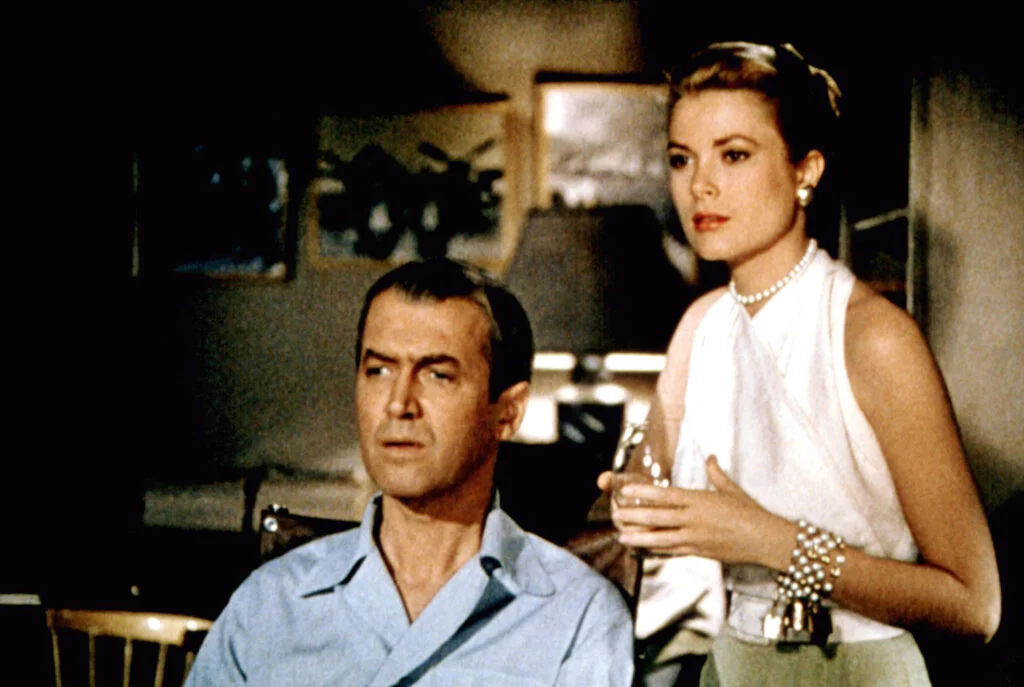
Stewart’s collaboration with Alfred Hitchcock produced several masterpieces, but his performance as photographer L.B. Jefferies in “Rear Window” stands out for its emotional complexity and vulnerability. Confined to a wheelchair with a broken leg, Jefferies begins watching his neighbors across the courtyard to alleviate boredom, only to become convinced one has murdered his wife. Stewart brilliantly conveys the character’s progression from casual voyeur to obsessed amateur detective, all while exploring Jefferies’ fear of commitment to his girlfriend Lisa (Grace Kelly). Stewart’s performance is remarkable for how it requires him to react to events largely through observation rather than action, with his expressive face communicating mounting horror, excitement, and ultimately terror as his suspicions prove correct.
What elevates this performance beyond mere thriller protagonist is Stewart’s willingness to expose Jefferies’ less admirable qualities—his emotional detachment, his dismissive attitude toward Lisa’s affections, and his voyeuristic objectification of his neighbors. Stewart never softens these aspects of the character yet still maintains audience sympathy through his fundamental decency and growing self-awareness. The film’s climactic confrontation, where the wheelchair-bound Jefferies must face the murderer with only camera flashes as a weapon, showcases Stewart’s ability to convey absolute terror while maintaining the character’s determination, creating a vulnerability rarely seen in male protagonists of the era. Through this performance, Stewart helped create a new kind of film hero—one whose emotional weaknesses are as important to the story as his moral strengths.
6. Scottie Ferguson in “Vertigo” (1958)
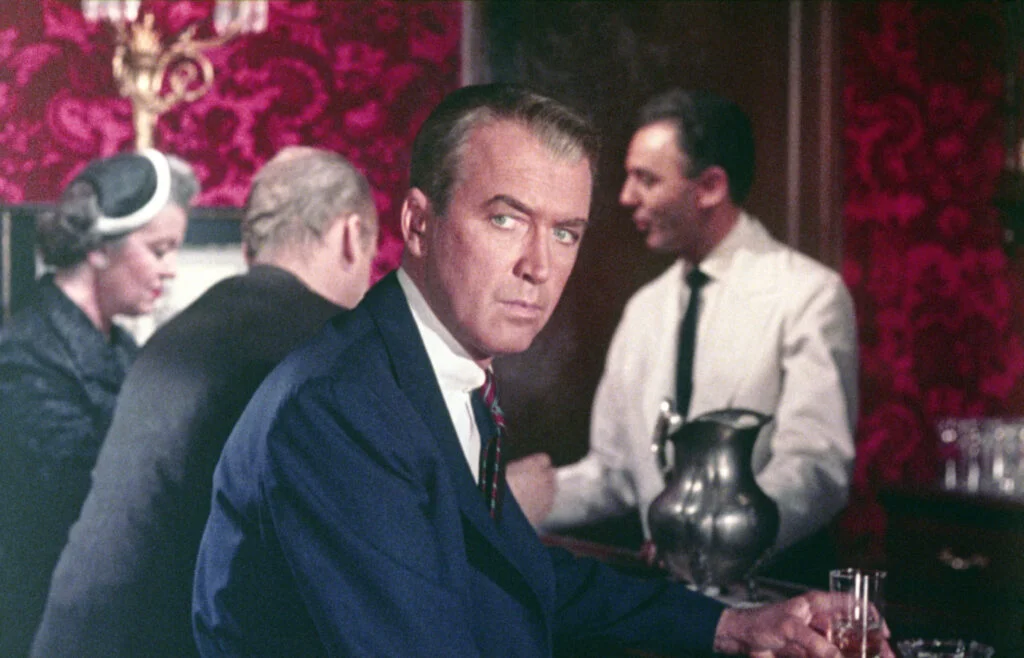
In what many critics now consider his most complex and disturbing performance, Stewart portrayed retired detective John “Scottie” Ferguson, a man whose acrophobia (fear of heights) and associated vertigo led to a fellow officer’s death, leaving him psychologically damaged. When an old acquaintance hires him to follow his supposedly possessed wife Madeleine (Kim Novak), Scottie becomes obsessed with the mysterious woman, only to witness her apparent suicide—a tragedy that drives him to the edge of madness. Stewart’s portrayal of Scottie’s deterioration is remarkable for its willingness to explore increasingly dark psychological territory, with the actor systematically deconstructing his familiar screen persona to reveal disturbing depths of obsession, manipulation, and emotional cruelty.
The latter half of the film, where Scottie encounters a woman named Judy who resembles Madeleine and attempts to remake her in Madeleine’s image, showcases Stewart at his most unsettling and heartbreaking. His portrayal of Scottie’s psychological compulsion goes beyond simple obsession to reveal a profound spiritual emptiness—a man trying to resurrect the dead through sheer force of will, regardless of the psychological damage inflicted on himself or Judy. The famous revelation scene, where Scottie finally understands how he’s been manipulated, allows Stewart to deliver a masterclass in reactive acting, his face registering shock, rage, heartbreak and horrified self-recognition in a matter of moments. Through this performance, Stewart helped expand the emotional possibilities of mainstream film acting, demonstrating that even the most beloved star could venture into psychological territories that remain disturbing and profoundly moving decades later.
7. Rupert Cadell in “Rope” (1948)

In one of his darkest roles, Stewart portrayed Rupert Cadell, a former professor whose Nietzschean philosophizing about superior individuals being “beyond” conventional morality inadvertently inspires two former students to commit murder as an intellectual exercise. Shot in a series of long takes designed to create the illusion of a single continuous shot, “Rope” required Stewart to build his performance with theatrical precision while maintaining cinematic intimacy. The brilliance of his portrayal lies in Cadell’s gradual transformation from glib, witty dinner guest to horrified moral authority as he realizes that his theoretical musings have been taken to their logical, murderous conclusion by his admiring students.
The film’s emotional climax comes as Stewart delivers a blistering repudiation of the killers’ actions and, by extension, his own previous philosophical position. This monologue represents one of Stewart’s most powerful screen moments, as Cadell’s sophisticated facade crumbles to reveal genuine moral outrage and personal responsibility. Stewart’s ability to convey profound ethical awakening through subtle shifts in vocal tone, posture, and facial expression makes this moment devastating in its impact—we witness not just a character’s realization but a fundamental recalibration of his entire worldview. By portraying a man forced to confront the real-world consequences of abstract philosophical positions, Stewart created a performance that continues to prompt viewers to examine the potential consequences of their own intellectual positions when divorced from human empathy.
8. Charlie Anderson in “The FBI Story” (1959)
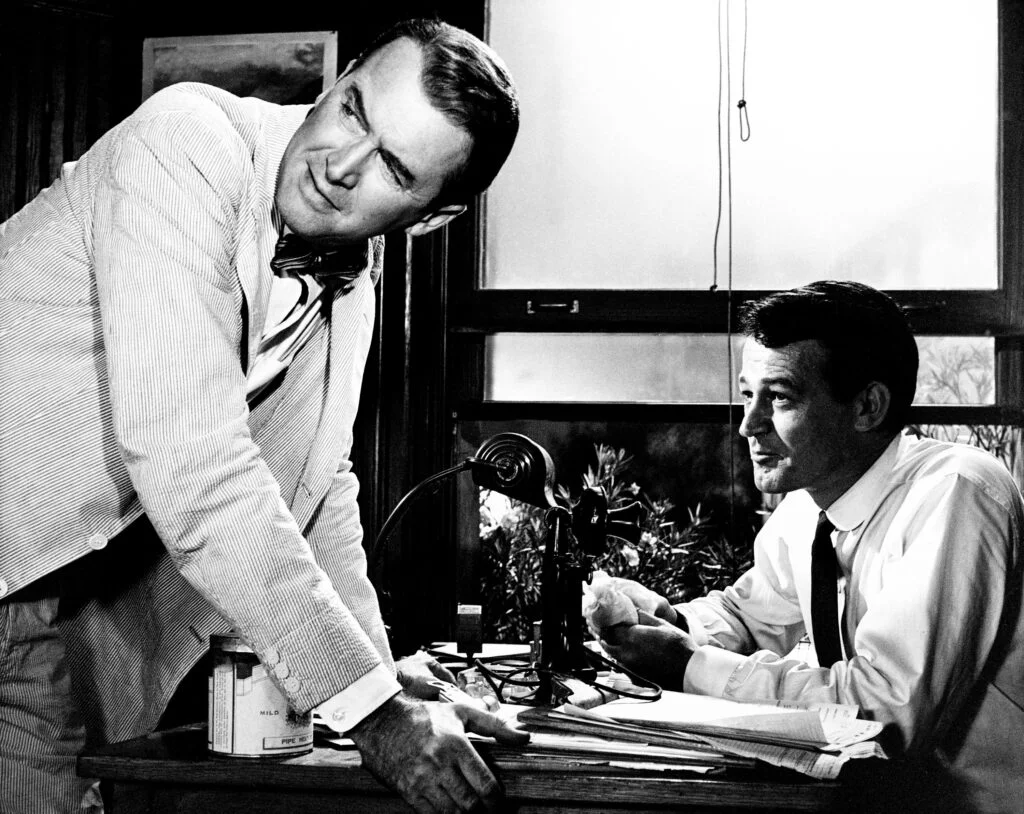
Stewart’s portrayal of FBI agent Charlie Anderson spans decades of the Bureau’s history, allowing him to create a moving portrait of a man whose professional dedication often comes at personal cost. What distinguishes this performance from standard biopic fare is Stewart’s ability to convey the accumulating emotional weight of Anderson’s career choices—the toll taken by years of placing duty above family life, of confronting human depravity, and of maintaining moral certainty in morally ambiguous situations. Stewart ages the character not just through makeup but through subtle alterations in energy, posture, and outlook, creating a compelling study of idealism tempered but not extinguished by experience.
The emotional core of Stewart’s performance emerges in the domestic scenes with Anderson’s wife Lucy (Vera Miles), where Stewart reveals the character’s struggle to balance professional commitment with family responsibilities. Particularly affecting is the sequence following their daughter’s death, where Stewart conveys devastation contained within the stoic demeanor expected of a man of his generation and profession. By the film’s conclusion, Stewart has crafted a moving portrait of principled public service with its associated sacrifices, creating an emotional resonance that transcends the film’s sometimes dated procedural elements. His Charlie Anderson remains a poignant study in how dedication to larger principles shapes an individual life, made human and relatable through Stewart’s characteristic emotional transparency.
9. Charles Lindbergh in “The Spirit of St. Louis” (1957)
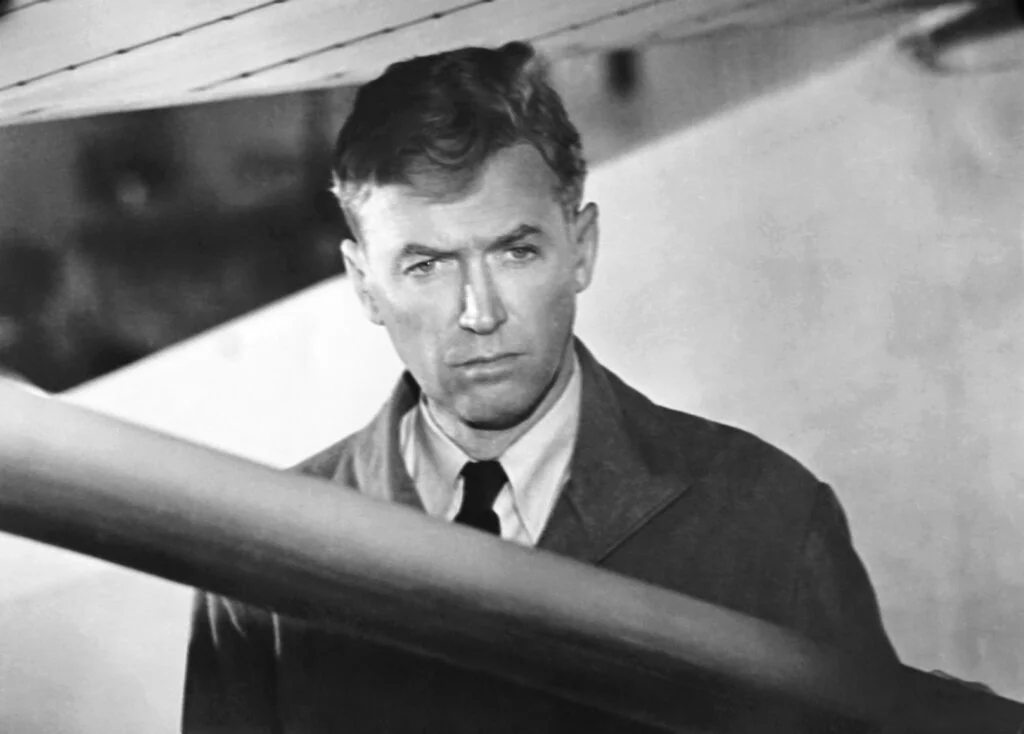
Stewart was forty-nine years old when he portrayed thirty-five-year-old Charles Lindbergh in this biopic about the aviator’s historic 1927 solo flight across the Atlantic, yet he brings such youthful determination and physical conviction to the role that viewers quickly forget the age discrepancy. What makes this performance particularly affecting is how Stewart captures both Lindbergh’s outward stoicism and inner vulnerability during the grueling thirty-three-hour flight. Much of the film features Stewart alone in the cramped cockpit, fighting fatigue, navigational challenges, and the psychological strain of isolation, requiring him to convey complex emotional states with minimal dialogue and often just his eyes and posture.
The emotional depth of Stewart’s performance emerges through his portrayal of Lindbergh’s moments of doubt and fear, which he experiences privately while maintaining the technical focus necessary for survival. Stewart’s background as a bomber pilot in World War II—where he flew twenty combat missions and rose to the rank of colonel—clearly informs his understanding of aviation’s combination of technical precision and existential vulnerability. Particularly moving are the sequences where an exhausted Lindbergh hallucinates conversations with childhood figures and spiritual presences, with Stewart seamlessly transitioning between alert determination and dreamlike confusion. By the film’s conclusion, Stewart has transformed what could have been simply a heroic biographical portrait into a moving meditation on human endurance and the subtle psychological costs of achievement.
10. Professor Jim Howard in “Take Her, She’s Mine” (1963)
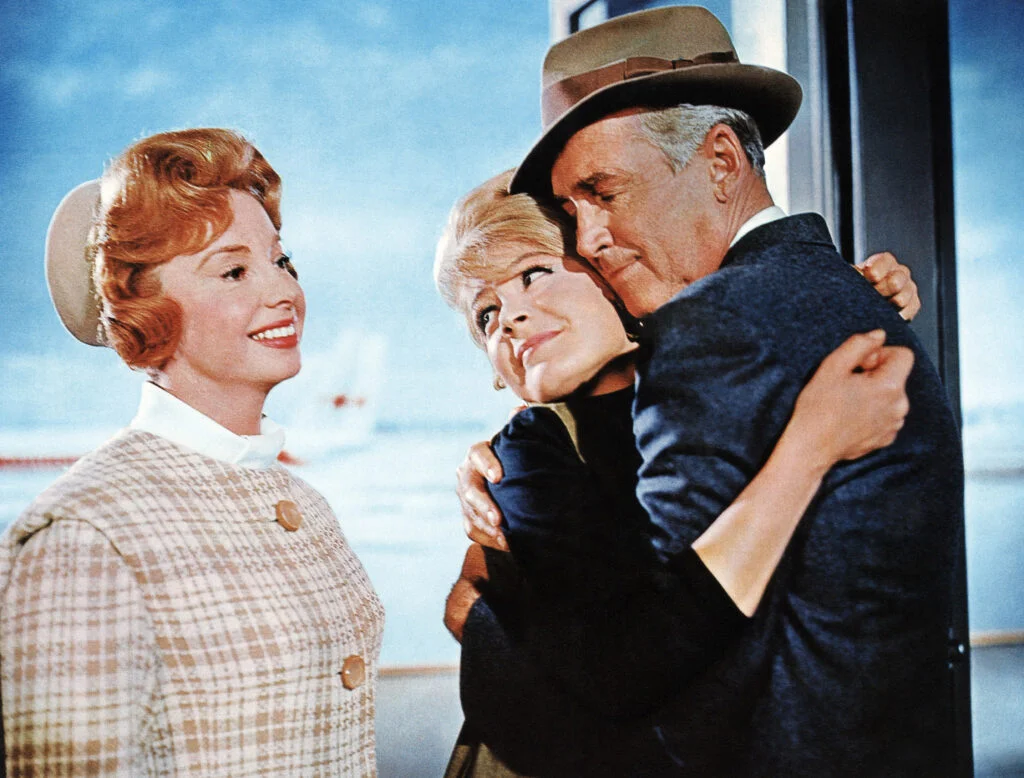
In this gentler comedy about a father struggling to adapt to his daughter’s coming of age, Stewart displayed the warmth and emotional accessibility that characterized his later career. As Professor Jim Howard, whose daughter (played by Sandra Dee) leaves for college in Paris and embraces 1960s youth culture, Stewart portrays parental anxiety with a touching combination of bewilderment, overprotectiveness, and underlying love. What could have been a one-note caricature of the conservative father confronting changing times becomes, through Stewart’s nuanced performance, a moving portrait of a man learning to evolve his understanding of parenthood while maintaining his core values.
The film’s emotional impact stems from Stewart’s ability to convey Jim’s growing realization that protecting his daughter means allowing her the freedom to make her own mistakes. Stewart portrays this difficult parental transition with remarkable subtlety—showing moments of genuine hurt when excluded from his daughter’s new life, flashes of righteous indignation when he believes she’s being taken advantage of, and quiet pride as he comes to recognize her growing independence. The performance resonates because Stewart never plays just for comedy, instead grounding Jim’s sometimes ridiculous behavior in authentic paternal concern that audience members of any generation can recognize. By finding the emotional truth in material that might otherwise seem dated, Stewart created a performance that continues to speak to the universal challenges of parenthood.
11. Ransom Stoddard in “The Man Who Shot Liberty Valance” (1962)
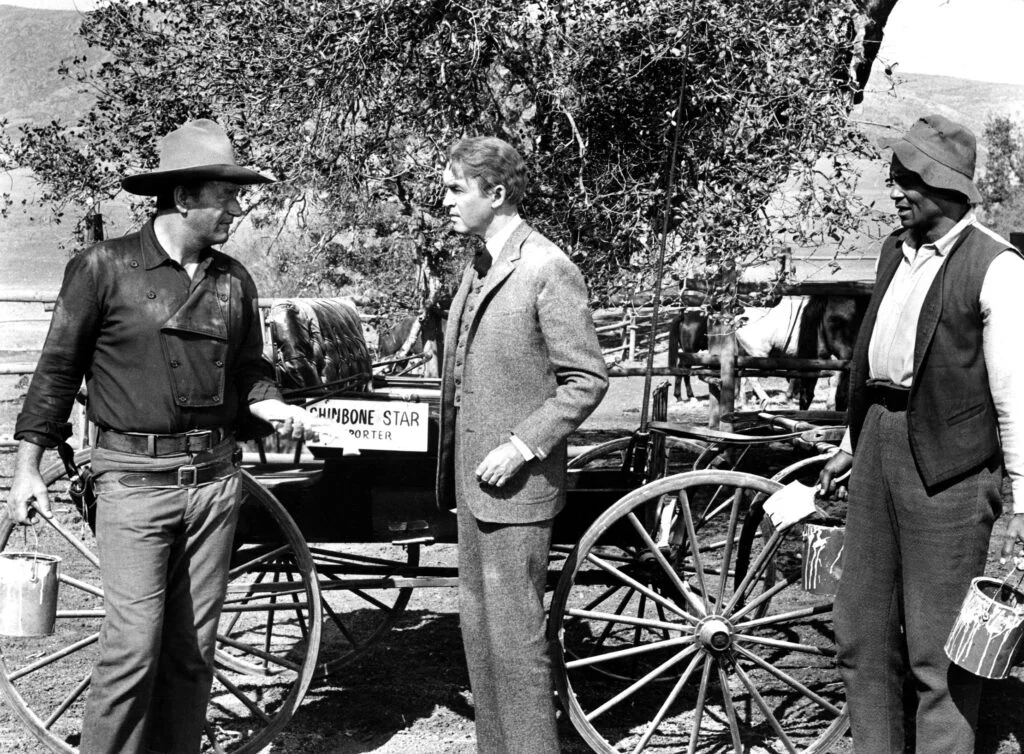
Stewart’s portrayal of eastern lawyer Ransom Stoddard, who reluctantly gains fame for supposedly killing notorious outlaw Liberty Valance, stands as one of his most nuanced explorations of heroism and its complexities. Playing opposite John Wayne’s Tom Doniphon, Stewart creates a character whose idealistic belief in law and civilization gradually gives way to a more complicated understanding of the violence underlying social order. What makes this performance particularly affecting is Stewart’s ability to show Stoddard’s moral evolution—from naive idealist horrified by frontier justice to a man who accepts that his reputation and political career are built on a necessary fiction about the circumstances of Liberty Valance’s death.
The emotional power of Stewart’s performance builds through the film’s unique structure, which features the elderly Stoddard recounting the truth about events that happened decades earlier. Stewart brilliantly differentiates between the younger Stoddard’s moral certainty and the older man’s melancholy understanding of compromise, particularly in the scenes where he finally reveals that it was Doniphon, not himself, who actually killed Liberty Valance from the shadows. The quiet dignity with which Stewart delivers the famous line, “When the legend becomes fact, print the legend,” conveys decades of living with both the benefits and moral burden of unearned heroism. Through this performance, Stewart created a poignant meditation on how historical narratives are constructed and the personal cost of living within myths created by others.
12. Glenn Miller in “The Glenn Miller Story” (1954)
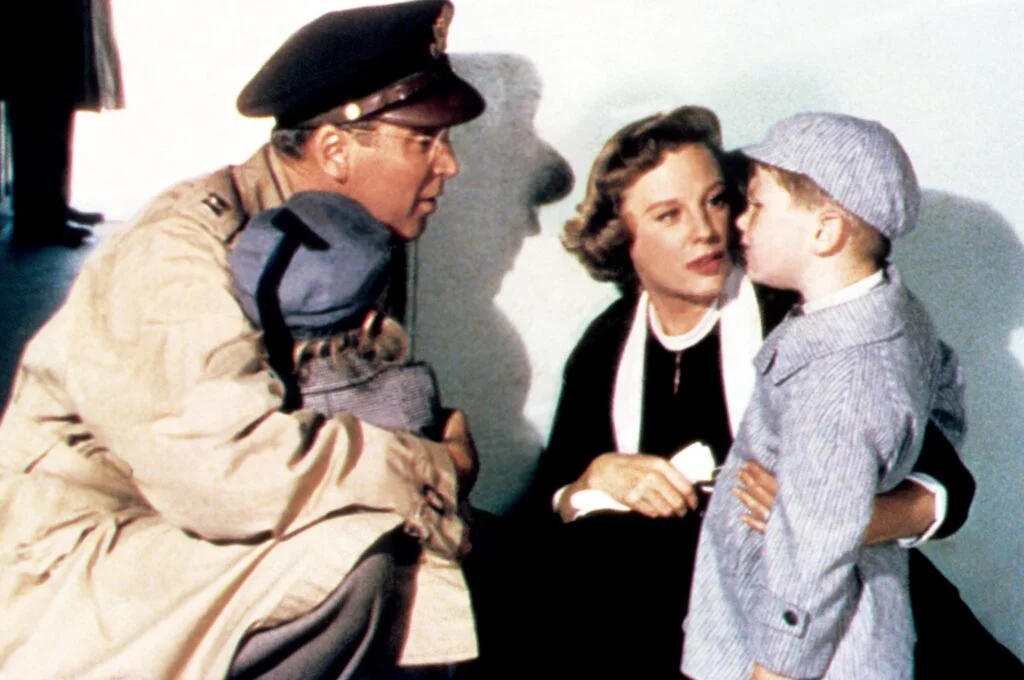
Stewart’s portrayal of bandleader Glenn Miller transcends the typical musical biopic through its authentic exploration of artistic frustration, perseverance, and the search for a distinctive creative voice. Rather than simply hitting biographical highlights, Stewart focuses on Miller’s internal struggle to develop his signature sound and the personal sacrifices required by his artistic commitment. The performance is particularly moving in sequences where Miller experiments with different arrangements, with Stewart conveying both the bandleader’s moments of discouragement and his flashes of inspiration with equal conviction. Stewart’s own musical background—he played accordion and sang occasionally—lends authenticity to these scenes, making Miller’s creative process feel genuinely lived rather than performed.
The emotional heart of Stewart’s performance emerges in Miller’s relationship with his wife Helen (June Allyson), particularly as he struggles to balance family obligations with professional ambition. Stewart portrays Miller’s occasional selfishness without judgment while never letting viewers forget the sincere love and consideration underlying the character’s choices. The film’s conclusion, addressing Miller’s mysterious disappearance during World War II when his plane was lost over the English Channel, achieves its poignancy through Stewart’s earlier establishment of Miller’s deep connection to his music and family. By portraying Miller as a man whose artistic achievement arose from personal dedication rather than innate genius, Stewart created a deeply relatable portrait of creative struggle and fulfillment that continues to resonate with viewers regardless of their familiarity with the bandleader’s music.
James Stewart’s ability to convey authentic emotion without sentimentality made him one of cinema’s most beloved actors, creating performances that continue to move audiences decades after they were filmed. His characters face moral dilemmas, personal failures, and profound losses with a humanity that transcends the changing conventions of film acting. In an industry often rewarding artifice and exaggeration, Stewart built his legacy on emotional honesty—finding the universal human experiences within each character and presenting them with a transparency that makes viewers feel less alone in their own struggles. These twelve performances represent not just remarkable acting achievements but genuine emotional connections across time, demonstrating cinema’s unique power to preserve and transmit human experience in its most authentic form.


